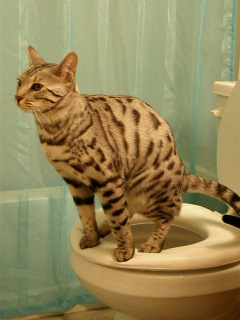How do you really feel with regards to Can You Flush Cat Poop Down The Toilet??

Intro
As pet cat owners, it's vital to be mindful of just how we get rid of our feline good friends' waste. While it might seem hassle-free to flush pet cat poop down the commode, this method can have destructive consequences for both the atmosphere and human wellness.
Alternatives to Flushing
The good news is, there are safer and more accountable methods to take care of pet cat poop. Think about the adhering to options:
1. Scoop and Dispose in Trash
One of the most typical method of disposing of feline poop is to scoop it right into an eco-friendly bag and throw it in the trash. Be sure to make use of a committed clutter scoop and deal with the waste promptly.
2. Usage Biodegradable Litter
Choose biodegradable cat trash made from materials such as corn or wheat. These trashes are eco-friendly and can be safely taken care of in the garbage.
3. Hide in the Yard
If you have a yard, take into consideration hiding pet cat waste in a designated area far from vegetable gardens and water sources. Make sure to dig deep sufficient to avoid contamination of groundwater.
4. Set Up a Pet Waste Disposal System
Purchase a pet garbage disposal system specifically developed for pet cat waste. These systems make use of enzymes to break down the waste, lowering smell and environmental effect.
Health Risks
Along with environmental problems, purging pet cat waste can likewise position wellness dangers to human beings. Feline feces may include Toxoplasma gondii, a bloodsucker that can cause toxoplasmosis-- a possibly serious health problem, specifically for expectant ladies and people with weakened immune systems.
Ecological Impact
Flushing feline poop presents hazardous microorganisms and bloodsuckers into the water supply, posturing a considerable risk to marine ecosystems. These contaminants can adversely impact marine life and compromise water high quality.
Final thought
Responsible pet possession expands beyond giving food and sanctuary-- it also includes appropriate waste monitoring. By refraining from flushing cat poop down the bathroom and selecting different disposal approaches, we can minimize our ecological impact and shield human wellness.
Why Can’t I Flush Cat Poop?
It Spreads a Parasite
Cats are frequently infected with a parasite called toxoplasma gondii. The parasite causes an infection called toxoplasmosis. It is usually harmless to cats. The parasite only uses cat poop as a host for its eggs. Otherwise, the cat’s immune system usually keeps the infection at low enough levels to maintain its own health. But it does not stop the develop of eggs. These eggs are tiny and surprisingly tough. They may survive for a year before they begin to grow. But that’s the problem.
Our wastewater system is not designed to deal with toxoplasmosis eggs. Instead, most eggs will flush from your toilet into sewers and wastewater management plants. After the sewage is treated for many other harmful things in it, it is typically released into local rivers, lakes, or oceans. Here, the toxoplasmosis eggs can find new hosts, including starfish, crabs, otters, and many other wildlife. For many, this is a significant risk to their health. Toxoplasmosis can also end up infecting water sources that are important for agriculture, which means our deer, pigs, and sheep can get infected too.
Is There Risk to Humans?
There can be a risk to human life from flushing cat poop down the toilet. If you do so, the parasites from your cat’s poop can end up in shellfish, game animals, or livestock. If this meat is then served raw or undercooked, the people who eat it can get sick.
In fact, according to the CDC, 40 million people in the United States are infected with toxoplasma gondii. They get it from exposure to infected seafood, or from some kind of cat poop contamination, like drinking from a stream that is contaminated or touching anything that has come into contact with cat poop. That includes just cleaning a cat litter box.
Most people who get infected with these parasites will not develop any symptoms. However, for pregnant women or for those with compromised immune systems, the parasite can cause severe health problems.
How to Handle Cat Poop
The best way to handle cat poop is actually to clean the box more often. The eggs that the parasite sheds will not become active until one to five days after the cat poops. That means that if you clean daily, you’re much less likely to come into direct contact with infectious eggs.
That said, always dispose of cat poop in the garbage and not down the toilet. Wash your hands before and after you clean the litter box, and bring the bag of poop right outside to your garbage bins.
https://trenchlesssolutionsusa.com/why-cant-i-flush-cat-poop/

As a reader on How to Dispose of Cat Poop and Litter Without Plastic Bags, I assumed sharing that portion was a great idea. Do you know about another individual who is involved in Don’t flush cat feces down the toilet? Please feel free to promote it. Many thanks for taking the time to read it.
Book An Appointment